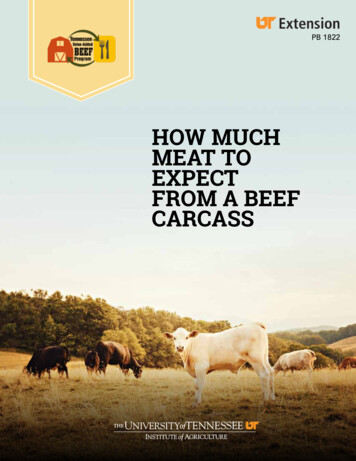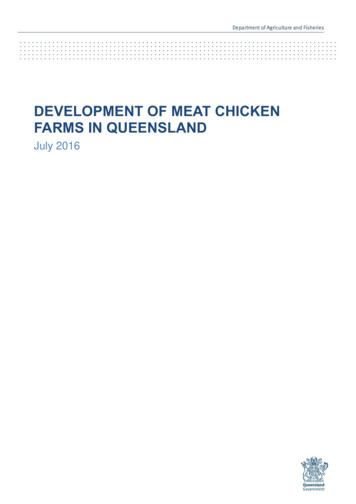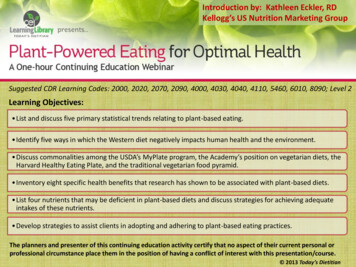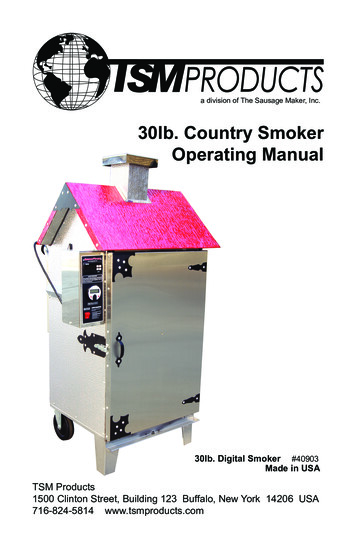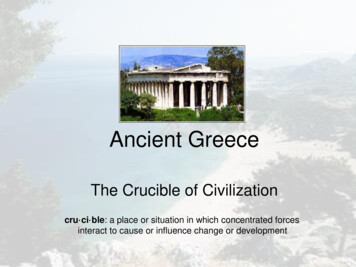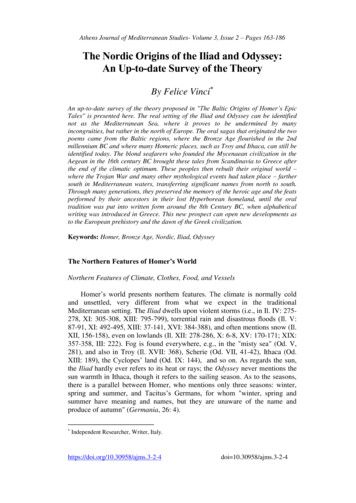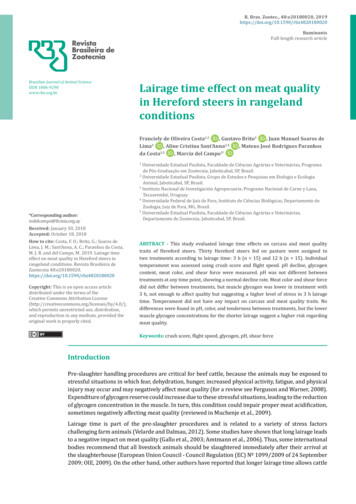
Transcription
R. Bras. Zootec., 48:e20180020, Full-length research articleBrazilian Journal of Animal ScienceISSN 1806-9290www.rbz.org.brLairage time effect on meat qualityin Hereford steers in rangelandconditionsFranciely de Oliveira Costa1,2, Gustavo Brito3, Juan Manuel Soares de3Lima, Aline Cristina Sant’Anna2,4, Mateus José Rodrigues Paranhosda Costa2,5, Marcia del Campo3*1*Corresponding author:mdelcampo@tb.inia.org.uyReceived: January 30, 2018Accepted: October 18, 2018How to cite: Costa, F. O.; Brito, G.; Soares deLima, J. M.; Sant’Anna, A. C.; Paranhos da Costa,M. J. R. and del Campo, M. 2019. Lairage timeeffect on meat quality in Hereford steers inrangeland conditions. Revista Brasileira deZootecnia Copyright: This is an open access articledistributed under the terms of theCreative Commons Attribution /),which permits unrestricted use, distribution,and reproduction in any medium, provided theoriginal work is properly cited.Universidade Estadual Paulista, Faculdade de Ciências Agrárias e Veterinárias, Programade Pós-Graduação em Zootecnia, Jaboticabal, SP, Brasil.2Universidade Estadual Paulista, Grupo de Estudos e Pesquisas em Etologia e EcologiaAnimal, Jaboticabal, SP, Brasil.3Instituto Nacional de Investigación Agropecuaria, Programa Nacional de Carne y Lana,Tacuarembó, Uruguay.4Universidade Federal de Juiz de Fora, Instituto de Ciências Biológicas, Departamento deZoologia, Juiz de Fora, MG, Brasil.5Universidade Estadual Paulista, Faculdade de Ciências Agrárias e Veterinárias,Departamento de Zootecnia, Jaboticabal, SP, Brasil.ABSTRACT - This study evaluated lairage time effects on carcass and meat qualitytraits of Hereford steers. Thirty Hereford steers fed on pasture were assigned totwo treatments according to lairage time: 3 h (n 15) and 12 h (n 15). Individualtemperament was assessed using crush score and flight speed. pH decline, glycogencontent, meat color, and shear force were measured. pH was not different betweentreatments at any time point, showing a normal decline rate. Meat color and shear forcedid not differ between treatments, but muscle glycogen was lower in treatment with3 h, not enough to affect quality but suggesting a higher level of stress in 3 h lairagetime. Temperament did not have any impact on carcass and meat quality traits. Nodifferences were found in pH, color, and tenderness between treatments, but the lowermuscle glycogen concentrations for the shorter lairage suggest a higher risk regardingmeat quality.Keywords: crush score, flight speed, glycogen, pH, shear forceIntroductionPre-slaughter handling procedures are critical for beef cattle, because the animals may be exposed tostressful situations in which fear, dehydration, hunger, increased physical activity, fatigue, and physicalinjury may occur and may negatively affect meat quality (for a review see Ferguson and Warner, 2008).Expenditure of glycogen reserve could increase due to these stressful situations, leading to the reductionof glycogen concentration in the muscle. In turn, this condition could impair proper meat acidification,sometimes negatively affecting meat quality (reviewed in Muchenje et al., 2009).Lairage time is part of the pre-slaughter procedures and is related to a variety of stress factorschallenging farm animals (Velarde and Dalmau, 2012). Some studies have shown that long lairage leadsto a negative impact on meat quality (Gallo et al., 2003; Amtmann et al., 2006). Thus, some internationalbodies recommend that all livestock animals should be slaughtered immediately after their arrival atthe slaughterhouse (European Union Council - Council Regulation (EC) Nº 1099/2009 of 24 September2009; OIE, 2009). On the other hand, other authors have reported that longer lairage time allows cattle
Lairage time effect on meat quality in Hereford steers in rangeland conditionsCosta et al.2to recover from the stress of transport with a positive effect on the meat acidification process (Mounieret al., 2006; del Campo et al., 2010).The impact of lairage time on meat quality is mediated by stress physiology, and there is clear evidencethat cattle with more excitable temperaments are more susceptible to stressful situations (Curley et al.,2008; Cafe et al., 2011a). Some studies show that more excitable cattle have higher ultimate pH andshear force values and higher incidence of dark cuts (Voisinet et al., 1997; del Campo et al., 2010; Hallet al., 2011; Coutinho et al., 2017). However, the relationship between temperament and meat qualityseems to be more complex, since some authors have failed to find significant effects (Turner et al.,2011) or do not agree about which meat quality indicators are affected by which temperament traits(King et al., 2006; Behrends et al., 2009; Cafe et al., 2011b; Hall et al., 2011).Most of the cited studies have explored the isolated effect of either lairage time or temperament onmeat quality. Thus, the objective of this study was to evaluate the effects of lairage time on carcass andmeat quality traits of Hereford steers in extensive conditions in Uruguay. The relationship betweentemperament and meat quality traits was also assessed in this experiment.Material and MethodsThe research protocol of the current study was approved by the Committee for the Ethical Use ofAnimals (Protocol number 2011/1).Thirty castrated Hereford steers were kept on grazing system with continuous stocking in a singlegroup at an experimental farm in Paysandú, Uruguay (32 00'24.21" S, 57 08'05.84" W, 110 m). Theanimals were weighed every 15 days during the finishing period to assess weight gain and set the timefor slaughter. Slaughter was performed when the animals reached an average of 500 kg of live weight,being three years old at that time.Temperament assessment was carried out simultaneously with weighing, evaluated by a trainedobserver, one week before the steers went to the slaughterhouse. Two temperament measurementswere used: crush score (CS; adapted by Grandin, 1993) – assessed just after the entry of the animalinto the squeeze chute (without using physical restraint in the head bail) by applying a visual scorefrom 1 (calm) to 4 (excitable) considering movements of limbs, head, and tail, with audible breathing,vocalization, visible white of eye, as well as behavioral signs of tension and stress; CS records weretaken 4 s after closing the squeeze chute gates; and flight speed (FS), defined by the speed (m/s)taken by each animal to cover a known distance (in this case, 2 m) just after being released from thesqueeze chute, as per Burrow et al. (1988). Faster animals were considered to have a more excitabletemperament (Burrow, 1997).Animals from both lairage times (treatments) remained grazing until loading (without fasting onfarm). The distance between the farm and the slaughterhouse (located in Salto, Uruguay, 31 24'14.63" S,57 59'28.09" W, 29 m) was 178 km, and the length of the journey was 3.5 h on average, with threeshort stops for monitoring the animals. The transport was done in one non-articulated truck, with onedeck and two load compartments, ensuring 1.2 m2/animal, according to Uruguayan cattle transportrequirements. The same driver did both trips, using the same truck, and no problems were recordedduring the journeys.The steers were randomly assigned to two treatments, according to lairage time in the slaughter plant:3 h (from 7:00 to 10:00 h, n 15) and 12 h (from 18:00 to 6:00 h of the next day, n 15). Steers fromeach treatment remained in covered pens with concrete floors, divided in two groups (eight and sevenanimals) following the international requirements for space allowance (420 kg/2.5 m²). The groupswere not considered as replicates. Animals were fastened during the transport and lairage period andhad ad libitum access to water in the lairage pen. Animals from both treatments were slaughteredduring the morning of the same day in a slaughterhouse enabled for export, following animal welfarestandards.R. Bras. Zootec., 48:e20180020, 2019
3Lairage time effect on meat quality in Hereford steers in rangeland conditionsCosta et al.Carcasses were graded using the Uruguayan Grading System (INAC, 1997) based on theconformation and fatness scores. Carcass conformation was based on a visual assessmentof muscle mass development, with lower numbers indicating better conformation (1 goodmuscle development and 6 poor muscle development), being classified as I, N, A, C, U, and Raccording to the conformation score system from Uruguay. Fat finishing was based on the amountand distribution of subcutaneous fat, using a five-grade scale, in which lower numbers indicatelack of fat cover and higher numbers, excessive covering, grading 0, 1, 2, 3, or 4 according to themethodology used in Uruguay.Samples of approximately 20 g of the Longissimus thoracis et lumborum muscles (LTL; between the11th and the 13th ribs) were extracted from 14 carcasses (seven from each treatment) at 45 minpost mortem to determine glycogen content. Samples were wrapped in aluminum foil and frozen at 80 C in nitrogen immediately after extraction. Glycogen content was determined in 2 g of muscle,heated to 100 C in a test tube with 8 mL of 2 M HCl for 2 h, then filtered and neutralized with 2 N NaOH(del Puerto et al., 2011). Measurements were taken using the glucose oxidase procedure, in whichthe residues were measured (Passonneau and Lowry, 1993). Results were expressed as milligrams ofglucose residue per gram of muscle (mg/g).Carcass pH was measured on the left side of all carcasses (n 15 for each treatment), in the LTL muscle(between the 11th and the 13th rib) at 1, 3, 6, 24, and 48 h post mortem, using a pH meter (Orion 210A)with gel device; assuming the 24 h post mortem measurement as the ultimate pH (pHu).One steak per animal (n 15 for each treatment) from the LTL muscle (between the 11th and the13th ribs) was vacuum-packaged individually and transported to the laboratory. The steak (2.54 cmthickness) was aged for two days at 2-4 C, and after that, meat color and shear force (WBSF) weremeasured. Meat color was measured on the LTL for L* (lightness), a* (redness), and b* (yellowness)color spaces (CIE, 1986), using a Minolta C 400 colorimeter, after 1 h of blooming. Values were registeredfrom three different locations on the upper side of the steak to obtain a representative averagevalue.The same sample was put into a polyethylene bag and cooked in a water bath for 1.5 h until an internaltemperature of 70 C was achieved (checked by a Barnant 115 thermometer with type E thermocouple).Six cores, 1.27 cm diameter, were removed from each steak parallel to the muscle fiber orientation.Shear force measurement was obtained for each core using a texturometer (Warner Bratzler – Model D2000), and an average value was calculated for each steak.To evaluate the effect of lairage time and temperament on carcass and meat quality traits, analysisof variance was used fitting a general linear model. The interactions between treatments and CS orFS were firstly tested using GLM procedure of SAS (Statistical Analysis System, version 9.4.). Becauseno significant interactions were found, the final models included only the main effects (lairage times,CS, and FS). Before the inclusion of both CS and FS together as fixed effects in the statistical models,Pearson’s coefficient of correlation was first calculated between them, showing that both temperamentindicators were not associated (r 0.08; P 0.698) and, therefore, express different facets of cattletemperament.For these analyses, the flight speed variable was categorized into three classes based on terciles, asfollows: low FS (calmer animals; 0.04 to 0.41 m/s), medium FS (medium temperament; 0.42 to0.46 m/s), and high FS (more excitable animals; 0.50 to 0.90 m/s). Due to the low occurrence of animalsclassified with extreme scores for CS (N 2 for CS 1 and CS 4), this indicator was categorized intotwo classes: low CS (calmer animals; scores 1 2) and high CS (more excitable animals; scores 3 4).The following model was used:Yijk μ αi βj γk eijk,in which Yijk the observation; µ overall mean; αi the fixed effect of lairage time (3 and 12 h); βj the fixed effect of CS (low and high); γk the fixed effect of FS in classes (low, medium, and high);R. Bras. Zootec., 48:e20180020, 2019
Lairage time effect on meat quality in Hereford steers in rangeland conditionsCosta et al.4and eijk the error. Adjusted means were compared by the Tukey test and the results were consideredstatistically significant when P 0.05.ResultsBased on the Uruguayan classification system of carcass conformation, there were no differencesbetween treatments, as it was expected (P 0.05), with 90% of the animals graded as A and 10% gradedas C. For fatness cover, 86.67% of the carcasses was scored as grade 2 (fat moderately abundant andwith uniform distribution) and 13.33% as grade 1 (scarce cover with large areas without fat). Nodifferences were found in hot carcass weight between treatments (mean SD 268.79 2.97 kg for 3 hand 266.59 2.97 kg for 12 h lairage; P 0.05).The muscle glycogen content differed between treatments. Animals kept in lairage for 3 h showedlower muscle glycogen content than those kept for 12 h (Table 1).pH values did not differ between treatments at any of the evaluated times, with an adequate rate of pHdecline and with pHu (24h) values below 5.8 (means and SE are shown in Table 1). In addition, therewere no significant effects of lairage time on either meat color or WBSF (Table 2).In the present study, the FS SD was 0.44 0.19 m/s (n 29; min 0.04 and max 0.90 m/s). Consideringthe terciles, 34.48% of the animals had low FS (calmer animals; 0.04 to 0.41 m/s), 34.48% had mediumFS (medium temperament; 0.42 to 0.46 m/s), and 31.04% showed a high FS (more excitable animals;0.50 to 0.90 m/s). Regarding CS, 66.67% of the animals showed a low CS (calmer animals; scores 1 2)and 33.33% had a high CS (more excitable animals; 3 4).Crush score and FS did not affect muscle glycogen concentration, meat color, and WBSF (Table 3).Regarding pH, there was a significant effect of CS on pH at 6 and 24 h post mortem and of FS on pH at 24 hpost mortem (Table 4). In general, more excitable animals (high CS and FS) produced meat with lowerpH when compared with the calmer ones (low CS and FS). However, all pHu values were below 5.8 and,therefore, had no potential to compromise meat quality.Table 1 - Effect of lairage time on muscle glycogen concentration and pH values of Hereford steers collected atdifferent times post mortemLairage3h12 hNF-valueP-valueGlycogen (mg/g)3.30b 0.8510.36a 1.111416.330.003pH 1 h6.47 0.056.57 0.07290.920.346pH 3 h6.12 0.056.25 0.10291.170.291pH 6 h6.03 0.056.10 0.08290.650.427Data show average standard error.Means in the same column followed by different letters are different by the Tukey test (P 0.05).pH 24 h5.57 0.015.57 0.03290.030.865pH 48 h5.52 0.015.54 0.01291.440.242Table 2 - Effect of lairage time on meat color and Warner Bratzler Shear Force values of Hereford steersLairage3h12 hNumberF-valueP-valueL*29.38 0.3029.54 0.30290.110.748a*13.11 0.3013.14 0.24290.010.942b*4.94 0.155.36 0.16292.630.118L* - lightness of meat; a* - redness of meat; b* - yellowness of meat; WBSF - Warner Bratzler Shear Force (in Newton).Data show average standard error.Means in the same column followed by different letters are different by the Tukey test (P 0.05).WBSF (N)39.11 3.0036.86 2.65290.310.586R. Bras. Zootec., 48:e20180020, 2019
Lairage time effect on meat quality in Hereford steers in rangeland conditionsCosta et al.5Table 3 - Effect of temperament traits of Hereford steers on muscle glycogen concentration, meat color, andWarner Bratzler Shear Force -valueP-valueNo.191010109Glycogen (mg/g)8.42 1.34 (N 8)5.25 1.78 (N 6)2.800.1296.81 2.27 (N 5)7.90 1.50 (N 5)5.79 1.66 (N 4)0.470.641L*29.42 0.2629.50 0.370.020.88129.33 0.1929.52 0.4929.53 0.430.080.927a*12.94 0.2613.31 0.210.690.41513.08 0.3013.06 0.2913.24 0.420.080.926b*5.14 0.155.16 0.170.010.9225.01 0.185.13 0.215.31 0.240.520.602WBSF (N)34.06 2.0941.91 4.153.490.07437.38 2.3038.85 3.9137.73 3.660.050.951CS - crush score; FS - flight speed; L* - lightness of meat; a* - redness of meat; b* - yellowness of meat; WBSF - Warner Bratzler Shear Force(in Newton).Data show average standard error.Means in the same column followed by different letters are different by the Tukey test (P 0.05).Table 4 - Effect of temperament traits of Hereford steers on pH at different times post -valueP-valueNo.191010109pH 1 h6.57 0.066.47 0.070.980.3336.53 0.056.58 0.066.45 0.120.590.565pH 3 h6.28 0.056.09 0.132.500.1276.27 0.096.29 0.066.00 0.132.700.087pH 6 h6.17a 0.055.96b 0.094.390.0476.12 0.086.12 0.065.95 0.101.620.219CS - crush score; FS - flight speed.Data show average standard error.Means in the same column followed by different letters are different by the Tukey test (P 0.05).pH 24 h5.61a 0.025.53b 0.028.430.0085.61a 0.025.59ab 0.025.52b 0.034.670.019pH 48 h5.53 0.015.53 0.010.010.9055.53 0.015.54 0.015.52 0.010.300.743DiscussionAccording to Warriss (2003), values lower than 10 mg/g of muscle glycogen are critical for suitablemuscle acidification. Brown et al. (1990) reported that muscle glycogen concentration of 8 to 9 mg/gcan cause elevation of pH. In the present study, both treatments showed glycogen concentration valueseven under those proposed thresholds. Nevertheless, pH was not adversely affected.Muir et al. (1998) considered that pasture-raised animals are more susceptible to pre-slaughter stress,because they may have less muscle glycogen stores and, therefore, higher risk of increased meat pHwhen compared with grain-fed steers. The animals evaluated in the present experiment were raised onpasture, which may have contributed to the low muscle glycogen content registered for both treatmentsand especially for treatment of 3 h of lairage time.Even considering that both treatments had a proper acidification process, the low muscle glycogenconcentration registered with 3 h lairage may be associated with stress during the pre-slaughterhandling (Ferguson and Warner, 2008). Brown et al. (1990) also showed that some pre-slaughter stressfactors reduced glycogen concentrations in 30% of the evaluated animals, but these were not enough toaffect meat pHu values. In this case, the authors speculated that if these individuals had been subjectedto a little extra effort, there could have been detrimental consequences to meat quality, with reducedR. Bras. Zootec., 48:e20180020, 2019
6Lairage time effect on meat quality in Hereford steers in rangeland conditionsCosta et al.glycogen stores and higher pHu. It is worth noting that the exact glycogen level threshold needed forproper acidification may depend on factors related to the muscle characteristics and factors relatedto molecular processes involving apoptosis (Laville et al., 2009; Ouali et al., 2013). Thus, regardless ofwhether muscle acidification remains appropriate, low glycogen concentration should be consideredas a warning flag regarding animal welfare.Is important to mention that the digestive process has a longer lag phase when animals are pasturefed. In the present experiment, animals from treatment with 12 h lairage ruminated during the night(Costa, 2013); thus, glycogen levels after 12 h could probably have been an important component ofglucose availability. They probably had the opportunity to rest overnight when the environment of theslaughterhouse was quieter and could also have achieved some control over possible stress-inducedenergy intake caused by the new environment. In addition, these animals could have restored theirmuscle reserves from mobilized liver glucose and would have had greater time to restore muscleglycogen from gluconeogenesis during the resting period.As previously mentioned, there are different results on the effect of lairage time on pHu, with someauthors showing that longer lairage times result in meat with higher pHu (Gallo et al., 2003; Amtmannet al., 2006) and others indicating that longer lairage times result in lower pHu meat (Brown et al.,1990; Mounier et al., 2006; del Campo et al., 2010). These varying results should be expected, given themultifactorial character of these traits, leading the different study designs (physiological status of theanimals and lairage conditions) to produce different outcomes. Results from the present experimentsuggest that local or regional conditions should be considered when lairage duration has to be defined.In the present study, there were no significant effects of lairage time on either meat color or WBSF.These results may be directly influenced by the pH values for both treatments, since meat color andtenderness are directly affected by this variable (Abril et al., 2001). Similar results were reported byFerguson et al. (2007), who did not find significant effect of lairage time (3 and 18 h) on meat colorand WBSF. On the other hand, del Campo et al. (2010), comparing lairage times of 3 and 15 h, usingconditions similar to those evaluated in the present experiment (productive systems, transportationduration, slaughter plant facilities, and handling procedures) but including Braford animals, reportedthat the shorter the lairage time, the higher the pH and WBSF values. Those authors suggested thatearly differences in pH rate decline, probably in that case more influenced by animal temperament andbreed (Braford breed), could have determined differences in meat tenderness between treatments.Again, these differences may reflect the changes in pH values found in each of these studies. Therefore,in both experiments that were developed in the same context, the shorter lairage suggested a higherlevel of animal stress, which should be considered.Individual temperament could directly affect meat quality. In excitable animals, the stress responsesrelated to the activation of hypothalamic-pituitary-adrenal axis (HPA) and also the sympatho-adrenalmedullary responses can be more intense (Cafe et al., 2011a). Thus, in more “excitable/reactive”individuals, the depletion of muscular glycogen concentration would be more intense than in calmeranimals, increasing the risk of meat quality defects (Grandin, 1997; Petherick et al., 2002; King et al.,2006). However, in the present experiment, cattle temperament traits (CS and FS) did not affectmuscle glycogen concentration and meat color, consistent with other studies (McGilchrist, 2011;Coombes et al., 2014).Several authors have reported that excitable temperaments are related to higher WBSF (King et al.,2006; Behrends et al., 2009; del Campo et al., 2010; Hall et al., 2011; Coutinho et al., 2017). One ofthe factors that may underlie the relationship between temperament and WBSF is the post mortemproteolysis during aging, which may vary depending on cattle temperament, although Magolski et al.(2013) suggested that other alternative mechanisms may also explain this relationship.For Bos taurus (Aberdeen Angus and Limousin bulls) and frequently handled cattle, Turner et al.(2011) did not find significant effects of temperament on several meat quality traits, only some trendsfor the effect of FS and CS on instrumentally measured meat quality attributes (FS on L* and b* colorparameters and CS on shear force). They proposed that the temperament variation of the evaluatedR. Bras. Zootec., 48:e20180020, 2019
Lairage time effect on meat quality in Hereford steers in rangeland conditionsCosta et al.7animals was not enough to cause negative effects on meat quality. The Hereford animals studied hereinare considered even more docile than the other breeds of British origin (Tulloh, 1961; Stricklin et al.,1980). Moreover, they were handled using best management practices, contributing to their low levelof reactivity (Waiblinger et al., 2006; Petherick et al., 2009). Thus, our results support previous findingsreported by Turner et al. (2011), in which for calm cattle, the detrimental effects of temperament onmeat quality are not pronounced. Conversely, for purebred and crossbred Bos indicus or for tropicallyadapted crossbred cattle with higher levels of reactivity to handling, the risks of meat quality defects infunction of cattle temperament are considerable, as reported by several authors (Voisinet et al., 1997;Petherick et al., 2002; Kadel et al., 2006; Behrends et al., 2009; Coutinho et al., 2017).ConclusionsThe lower muscle glycogen storage in the short lairage is not enough to adversely affect pH, color, andtenderness. However, it suggests a higher risk regarding meat quality, implying that it could be betterto maintain animals in pens for 12 h before slaughter.Individual temperament differences in Hereford steers do not have any effect on meat quality.Controversial experimental results have been reported regarding the effects of lairage time onanimal welfare and meat quality, depending on the production systems and the general context of themeat production chain. Therefore, international entities such as the European Union and the WorldOrganization for Animal Health (OIE) should consider those differences and therefore, contextualizedscientific information, when writing worldwide regulations or recommendations. The findingspresented herein may be relevant for such decisions and may help further research required toestablish a proper lairage duration before slaughter, considering different situations and factors, likefeeding systems, pre-slaughter handling procedures, distances, and transport duration, among others.AcknowledgmentsThis research was funded by Instituto Nacional de Investigación Agropecuaria (INIA), Uruguay. Thestudy was part of the first author’s master thesis in the Graduate Program in Animal Science of theUniversidade Estadual Paulista (UNESP), Jaboticabal Campus, Brazil. Mateus Paranhos da Costathanks the Conselho Nacional de Desenvolvimento Científico e Tecnológico (CNPq) for the productivityfellowship.ReferencesAbril, M.; Campo, M. M.; Önenç, A.; Sañudo, C.; Albertí, P. and Negueruela, A. I. 2001. Beef color evolution as a function ofultimate pH. Meat Science 58:69-78. nn, V. A.; Gallo, C.; Van Schaik, G. and Tadich, N. 2006. Relaciones entre el manejo antemortem, variablessanguíneas indicadoras de estrés y pH de la canal en novillos. Archivos de Medicina Veterinaria 00300010Behrends, S. M.; Miller, R. K.; Rouquette Jr., F. M.; Randel, R. D.; Warrington, B. G.; Forbes, T. D. A.; Welsh, T. H.; Lippke, H.;Behrends, J. M.; Carstens, G. E. and Holloway, J. W. 2009. Relationship of temperament, growth, carcass characteristicsand tenderness in beef steers. Meat Science 81:433-438. , S. N.; Bevis, E. A. and Warriss, P. D. 1990. An estimate of the incidence of dark cutting beef in the United Kingdom.Meat Science 27:249-258. , H. M.; Seifert, G. W. and Corbet, N. J. 1988. A new technique for measuring temperament in cattle. AustralianSociety of Animal Production 17:154-157.Burrow, H. M. 1997. Measurements of temperament and their relationships with performance traits of beef cattle.Animal Breeding Abstracts 65:477-495.Cafe, L. M.; Robinson, D. L.; Ferguson, D. M.; Geesink, G. H. and Greenwood, P. L. 2011a. Temperament and hypothalamicpituitary-adrenal axis function are related and combine to affect growth, efficiency, carcass, and meat quality traits inBrahman steers. Domestic Animal Endocrinology 40:230-240. https://doi.org/10.1016/j.domaniend.2011.01.005R. Bras. Zootec., 48:e20180020, 2019
8Lairage time effect on meat quality in Hereford steers in rangeland conditionsCosta et al.Cafe, L. M.; Robinson, D. L.; Ferguson, D. M.; McIntyre, B. L.; Geesink, G. H. and Greenwood, P. L. 2011b. Cattle temperament:Persistence of assessments and associations with productivity, efficiency, carcass and meat quality traits. Journal ofAnimal Science 89:1452-1465. https://doi.org/10.2527/jas.2010-3304CIE - Commission International de l’Éclairage. 1986. Colorimetry. 2nd ed. Vienna.Coombes, S. V.; Gardner, G. E.; Pethick, D. W. and McGilchrist, P. 2014. The impact of beef cattle temperament assessed usingflight speed on muscle glycogen, muscle lactate and plasma lactate concentrations at slaughter. Meat Science 06.029Costa, F. O. 2013. Efeitos do tempo de espera em currais de frigorífico no bem-estar e na qualidade da carne de bovinos.Dissertação (M.Sc.). Universidade Estadual Paulista, Jaboticabal, SP, Brasil.Coutinho, M. A. S.; Ramos, P. M.; Luz e Silva, S.; Martello, L. S.; Pereira, A. S. C. and Delgado, E. F. 2017. Divergenttemperaments are associated with beef tenderness and the inhibitory activity of calpastatin. Meat Science 6.017Curley Jr., K. O.; Neuendorff, D. A.; Lewis, A. W.; Cleere, J. J.; Welsh Jr., T. H. and Randel, R. D. 2008. Functional characteristicsof the bovine hypothalamic–pituitary–adrenal axis vary with temperament. Hormones and Behavior 05del Campo, M.; Brito, G.; Soares de Lima, J. M.; Hernández, P. and Montossi, F. 2010. Finishing diet, temperament andlairage time effects on carcass and meat quality traits in steers. Meat Science 86:908-914. https://doi.org/10.1016/j.meatsci.2010.07.014del Puerto, M.; Rodríguez, S.; Cabrera, M. C. and Saadoun, A. 2011. Alimentación estratégica pre faena, reserva de glucógenomuscular y hepática y cambios en el pH del m. Pectoralis aviar. p.568. In: P
temperature of 70 C was achieved (checked by a Barnant 115 thermometer with type E thermocouple). Six cores, 1.27 cm diameter, were removed from each steak parallel to the muscle fiber orientation. Shear force measurement was obtained for each core using a texturometer (Warner Bratzler - Model D
